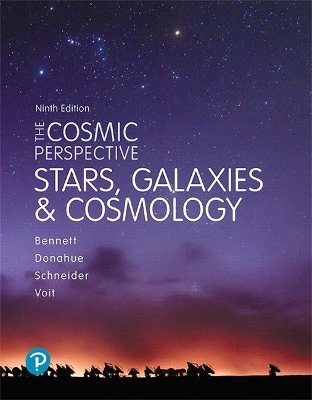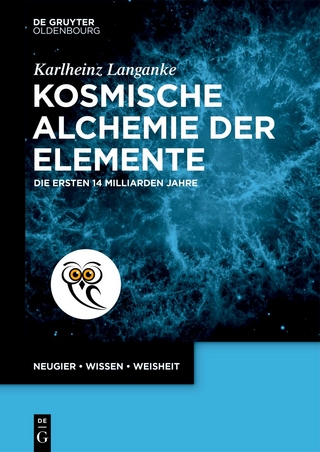
Cosmic Perspective, The
Pearson (Verlag)
978-0-13-499078-1 (ISBN)
- Titel z.Zt. nicht lieferbar
- Versandkostenfrei innerhalb Deutschlands
- Auch auf Rechnung
- Verfügbarkeit in der Filiale vor Ort prüfen
- Artikel merken
Exploring the impact of new discoveries on astronomy, science, and life in the universe
Building on a long tradition of effective pedagogy and comprehensive coverage, The Cosmic Perspective, 9th Edition provides a thoroughly engaging and up-to-date introduction to astronomy for anyone who is curious about the universe, regardless of prior background in astronomy or physics. As respected teachers and active researchers, the authors present astronomy using a coherent narrative and a thematic approach that engages students immediately and guides them through connecting ideas. This engagement-centered approach and variety of contextualizing features enhance student understanding of the process of science and actively involve them in learning key concepts.
The 9th Edition features major scientific updates, new content that focuses on the possibility of life in the universe, and recent discoveries that provide modern contexts to help students see astronomy as highly relevant to their worlds now. The authors integrate a new focus on cultural diversity among scientists and ethics across science and astronomy, delving into science done by a wide range of people and evaluated in different ways. The authors write and create a wealth of Mastering Astronomy resources, carrying the coherent and cohesive approach of the book to the new and expanded digital tools, such as Prelecture Videos. Instructors can access this curated group of activities in Mastering Astronomy for use before, during, and after class and can easily edit the pre-built assignments to fit the way they teach.
This text is also available in two volumes, which can be purchased separately:
The Cosmic Perspective: The Solar System, 9th Edition (includes Chapters 1–13, 14, S1, 24)
The Cosmic Perspective: Stars, Galaxies, and Cosmology, 9th Edition (includes Chapters 1-3, S1, 4–6, S2–S4, 14–24)
About our authors Jeffrey Bennett, a recipient of the American Institute of Physics Science Communication Award, holds a B.A. in biophysics (UC San Diego) and an M.S. and Ph.D. in astrophysics (University of Colorado). He specializes in science and math education and has taught at every level from preschool through graduate school. Career highlights include serving 2 years as a visiting senior scientist at NASA headquarters, where he developed programs to build stronger links between research and education, proposing and helping to develop the Voyage scale model solar system on the National Mall (Washington, DC) and developing the free app Totality by Big Kid Science to help people learn about total solar eclipses. He is the lead author of textbooks in astronomy, astrobiology, mathematics, and statistics and of critically acclaimed books for the public including Beyond UFOs (Princeton University Press), Math for Life (Bid Kid Science), What Is Relativity? (Columbia University Press), On Teaching Science (Big Kid Science), and A Global Warming Primer (Big Kid Science). He is also the author of six science picture books for children, titled Max Goes to Mars, Max Goes to Jupiter, Max Goes to the Space Station, Max Goes to the Moon, The Wizard Who Saved the World, and I, Humanity; all six have been launched to the International Space Station and read aloud by astronauts for NASA’s Story Time From Space program. His personal website is www.jeffreybennett.com. Megan Donahue is a full professor in the Department of Physics and Astronomy at Michigan State University (MSU), a Fellow of the American Physical Society and of the American Association for the Advancement of Science, and President of the American Astronomical Society (2018—2020). Her research focuses on using x-ray, UV, infrared, and visible light to study galaxies and clusters of galaxies: their contents–dark matter, hot gas, galaxies, active galactic nuclei–and what they reveal about the contents of the universe and how galaxies form and evolve. She grew up on a farm in Nebraska and received an S.B. in physics from MIT, where she began her research career as an x-ray astronomer. She has a Ph.D. in astrophysics from the University of Colorado. Her Ph.D. thesis on theory and optical observations of intergalactic and intracluster gas won the1993 Robert Trumpler Award from the Astronomical Society for the Pacific for an outstanding astrophysics doctoral dissertation in North America. She continued postdoctoral research as a Carnegie Fellow at Carnegie Observatories in Pasadena, California, and later as an STScI Institute Fellow at Space Telescope. Megan was a staff astronomer at the Space Telescope Science Institute until 2003, when she joined the MSU faculty. She is also actively involved in advising national and international astronomical facilities and NASA, including planning future NASA missions. Megan is married to Mark Voit, and they collaborate on many projects, including this textbook, over 70 peer reviewed astrophysics papers, and the nurturing of their children, Michaela, Sebastian, and Angela. Megan has run three full marathons, including Boston. These days she runs trails with friends, orienteers, and plays piano and bass guitar for fun and no profit. Nicholas Schneider is a full professor in the Department of Astrophysical and Planetary Sciences at the University of Colorado and a researcher in the Laboratory for Atmospheric and Space Physics. He received his B.A. in physics and astronomy from Dartmouth College in 1979and his Ph.D. in planetary science from the University of Arizona in 1988. His research interests include planetary atmospheres and planetary astronomy. One research focus is the odd case of Jupiter’s moon Io. Another is the mystery of Mars’s lost atmosphere, which he is helping to answer by leading the Imaging UV Spectrograph team on NASA’s MAVEN mission now orbiting Mars. Nick enjoys teaching at all levels and is active in efforts to improve undergraduate astronomy education. Over his career he has received the National Science Foundation’s Presidential Young Investigator Award, the Boulder Faculty Assembly’s Teaching Excellence Award, and NASA’s Exceptional Scientific Achievement Medal. Off the job, Nick enjoys exploring the outdoors with his family and figuring out how things work. Mark Voit is a full professor in the Department of Physics and Astronomy and Associate Dean for Undergraduate Studies at Michigan State University. He earned his A.B. in astrophysical sciences at Princeton University and his Ph.D. in astrophysics at the University of Colorado in 1990. He continued his studies at the California Institute of Technology, where he was a research fellow in theoretical astrophysics, and then moved on to Johns Hopkins University as a Hubble Fellow. Before going to Michigan State, Mark worked in the Office of Public Outreach at the Space Telescope, where he developed museum exhibitions about the Hubble Space Telescope and helped design NASA’s award-winning Hubble Site. His research interests range from interstellar processes in our own galaxy to the clustering of galaxies in the early universe, and he is a Fellow of the American Association for the Advancement of Science. He is married to coauthor Megan Donahue and cooks terrific meals for her and their three children. Mark likes getting outdoors whenever possible and particularly enjoys running, mountain biking, canoeing, orienteering, and adventure racing. He is also author of the popular book Hubble Space Telescope: New Views of the Universe.
The Cosmic Perspective, 9th Edition is available in 3 versions:
The Cosmic Perspective includes all chapters: CH 1-24 and S1-S4
The Cosmic Perspective: Solar System (ISBN: 9780134990774) includes CH1-14, S1, and CH24
The Cosmic Perspective: Stars and Galaxies (ISBN: 9780134990781) includes CH1-6, S1-S4, CH14-24
PART I. DEVELOPING PERSPECTIVE
1. A Modern View of the Universe
2. Discovering the Universe For Yourself
3. The Science of Astronomy
S1. Celestial Timekeeping and Navigation
PART II. KEY CONCEPTS FOR ASTRONOMY
4. Making Sense of the Universe: Understanding Motion, Energy, and Gravity
5. Light and Matter: Reading Messages from the Cosmos
6. Telescopes: Portals of Discovery
PART III. LEARNING FROM OTHER WORLDS
7. Our Planetary System
8. Formation of the Solar System
9. Planetary Geology: Earth and the Other Terrestrial Worlds
10. Planetary Atmospheres: Earth and the Other Terrestrial Worlds
11. Jovian Planet Systems
12. Asteroids, Comets, and Dwarf Planets: their Nature, Orbits, and Impacts
13. Other Planetary Systems: the New Science of Distant Worlds
PART IV. A DEEPER LOOK AT NATURE
S2. Space and Time
S3. Spacetime and Gravity
S4. Building Blocks of the Universe
PART V. STARS
14. Our Star
15. Surveying the Stars
16. Star Birth
17. Star Stuff
18. The Bizarre. Stellar Graveyard
PART VI. GALAXIES AND BEYOND
19. Our Galaxy
20. Galaxies and the Foundation of Modern Cosmology
21. Galaxy Evolution
22. The Birth of the Universe
23. Dark Matter, Dark Energy, and the Fate of the Universe
PART VII. LIFE ON EARTH AND BEYOND
24. Life in the Universe
Appendixes
Glossary
Credits
Index
| Erscheinungsdatum | 29.01.2019 |
|---|---|
| Reihe/Serie | Bennett Science & Math Titles |
| Sprache | englisch |
| Themenwelt | Naturwissenschaften ► Physik / Astronomie ► Astronomie / Astrophysik |
| ISBN-10 | 0-13-499078-1 / 0134990781 |
| ISBN-13 | 978-0-13-499078-1 / 9780134990781 |
| Zustand | Neuware |
| Informationen gemäß Produktsicherheitsverordnung (GPSR) | |
| Haben Sie eine Frage zum Produkt? |
aus dem Bereich


